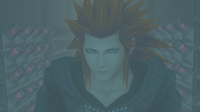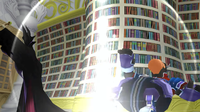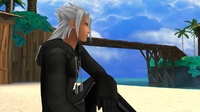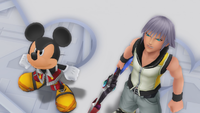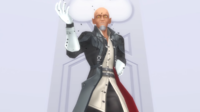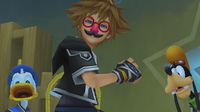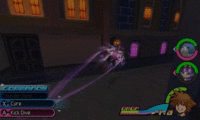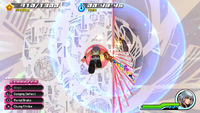Kingdom Hearts 3D: Dream Drop Distance
| Kingdom Hearts 3D [Dream Drop Distance] | |
|---|---|
| キングダム ハーツ 3D [ドリーム ドロップ ディスタンス] Kingudamu Hātsu 3D [Dorīmu Doroppu Disutansu] | |
| Developer(s) | Square Enix |
| Publisher(s) | Square Enix |
| Release date(s) | |
| Genre | Console action role-playing game |
| Game modes | Single player |
| Ratings | CERO: ESRB: PEGI: OFLC: |
| Platform(s) | Nintendo 3DS |
- "Darkness becomes light, light falls into darkness."
- —Tagline
Kingdom Hearts 3D: Dream Drop Distance is the seventh game in the Kingdom Hearts series. It was originally developed for the Nintendo 3DS hand-held system. It is a direct sequel to Kingdom Hearts II, Kingdom Hearts coded, and the epilogue of Kingdom Hearts Birth by Sleep.
The game is focused on Sora and Riku, who are both playable characters, performing their Mark of Mastery exam. They visit new worlds in their sleep in order to improve their abilities as Keyblade Wielders. Many important story revelations also occur which help explain certain aspects of Kingdom Hearts III.
The game opening theme is the orchestral arrangement of "Hikari", while "Sanctuary -after the battle-" is used as the game ending theme.
The game was remastered in HD as Kingdom Hearts Dream Drop Distance HD, released as part of Kingdom Hearts HD 2.8 Final Chapter Prologue.
Development[edit]
The game was first announced at E3 2010, simply known as Kingdom Hearts 3D. A demo version of the game was made available on the Nintendo eShop on June 22, 2012. Kingdom Hearts 3D: Dream Drop Distance is the first game in the series to see a release in Europe and Australia before North America.
Pre-production began while Birth By Sleep was wrapping production, with most of the team returning to work on this new entry. Developers that worked on The World Ends with You were also brought on, which is why characters from that game appeared in place of Final Fantasy characters. During conceptualization, Tetsuya Nomura wanted to improve movement and combat to be flashier and more dynamic. This eventually led to the creation of Flowmotion. After deciding what system to make the game for, the team decided on the Nintendo 3DS due to the team liking the final hardware. The handheld systems's high-spec graphics processing made the game's graphics nearly on-par with those of the PS2 titles, and system's 3D technology was used to add immersion when falling from high places and flying far distances.[6] The 3D effect is used more for "going into the screen" rather than things popping out.[7]
The development team was selecting worlds, planning to use all-new Disney worlds, along with Traverse Town and other original worlds,[8] one of which was revealed to be based on The Hunchback of Notre Dame—although the world itself was featured earlier in the non-canonical The Sceptre and the Kingdom.
Nomura stated that with the parallel development of Final Fantasy Versus XIII (now Final Fantasy XV) made the titles feel similar. However, he assured that he would make sure to retain any game elements that can't be put in that game for use in Dream Drop Distance.[9] Nomura also stated the transition between playing as Sora and playing as Riku is forced and sudden, and can occur while simply walking around. The game also has the keyword of "drop", as in something falling.
In the July, 2011 issue of Weekly Famitsu, Nomura stated the game focuses on the "hidden data" inside Sora. A secret movie was confirmed, along with new characters in Traverse Town. Nomura stated that the Xehanort Saga ends with Kingdom Hearts III and there are answers about Kingdom Hearts III in Dream Drop Distance.[10]
A trailer and a playable demo were shown at the 2011 Tokyo Game Show. The demo included Neku Sakuraba, the protagonist of another Square Enix title, The World Ends with You,[11] and showed Sora and Riku's new outfits,[12] and the first official confirmation of the game's new species, Dream Eaters, which serve as both party members and generic enemies. The game was confirmed for a Spring 2012 release in Japan, and Nomura claimed that it was 60-70% complete.
November 2011 issues of Famitsu and V Jump confirmed worlds based on Pinocchio (Prankster's Paradise), and The Hunchback of Notre Dame (La Cité des Cloches). The same issue also featured the return of the "Drop" gauge seen in the Square Enix Premier Party Trailer but absent in the TGS 2011 trailer. The December issue of V Jump announced the inclusion of "Country of the Musketeers", a world based on Mickey, Donald, Goofy: The Three Musketeers, making it the first world to originate from a direct-to-video feature. It also revealed the inclusion of Joshua and Beat from The World Ends with You.
During Jump Festa 2012, a playable demo and a trailer were shown. The trailer shows the return of Lea, the unknown figure from Kingdom Hearts Birth by Sleep, shown without his hood, and Ventus. Shiki and Rhyme also appeared alongside Neku. The game was announced to have a release date in March 2012.[13] "The Grid", a world based on Tron: Legacy, was revealed, and like Space Paranoids in Kingdom Hearts II, Sora and Riku's outfits change to match the location.[14]
"Mementos", a feature announced on the official Kingdom Hearts blog, provides a summary of previously released Kingdom Hearts games. It is also a facsimile to Theater Mode, containing all cutscenes viewed up to the player's point in the game. Like Kingdom Hearts Re:coded, the game has two save slots.
After a relatively short development time of roughly two years, the game finally released on March 29, 2012 in Japan. An updated version patch from v1.0 to v1.1 was released on May 25, 2012,[15] which fixes several minor bugs in the initial release. This was the version used for the international release later that year in July.
Setting[edit]
The game picks up after the events of Kingdom Hearts Re:coded's secret ending, Signs of What's Next, and also has connections to Kingdom Hearts Birth by Sleep, Kingdom Hearts 358/2 Days, and Kingdom Hearts coded. Like in the case of Kingdom Hearts Birth by Sleep, Tetsuya Nomura has stated that the story is on par with that of a numbered title.[16] The setting of Kingdom Hearts 3D: Dream Drop Distance is again spread across several worlds; several original worlds return, such as Traverse Town and The World That Never Was, but all of the Disney-based worlds are brand new to the series.[8] Several other worlds appear only in cutscenes, such as Disney Castle, The Mysterious Tower, Radiant Garden, Twilight Town, and Castle Oblivion.
Story[edit]
In Radiant Garden, Braig wanders into the computer room of Hollow Bastion and finds Even and Ienzo lying unconscious on the floor with specks of darkness emanating from them. The only other one present in the room is Terra-Xehanort, whom Braig questions. Terra-Xehanort responds by summoning Master Xehanort's Keyblade and stabbing Braig through the chest with it, extracting his heart. As Braig loses consciousness, Terra-Xehanort declares that he is now "Ansem".
More than ten years later, Yen Sid puts Sora and Riku through a Mark of Mastery exam in order for them to become full-fledged Keyblade Masters and counter the coming return of Master Xehanort. As part of this trial, the two are sent to several worlds that have been restored from the Heartless' attack following the defeat of Ansem, Seeker of Darkness, but have gone into a state of "deep sleep" that disconnects them from the other worlds. These worlds are plagued by Dream Eaters—creatures born from darkness that seek out the sleeping worlds' Keyholes. Sora and Riku's given task is to reawaken the sleeping worlds by unlocking the seven Keyholes they find there and then return to the Realm of Light, after which they will be deemed Keyblade Masters and acquire the power of waking, the ability to free hearts from sleep. The two travel through the sleeping worlds independently from each other after being separated at the beginning of the exam, and recruit benevolent "Spirit" Dream Eaters to aid them in finding the Keyholes and battling the malevolent "Nightmare" Dream Eaters that try to destroy the worlds.
Meanwhile, back in Radiant Garden, Lea awakens and realizes that he has been restored to his original form following the destruction of his Nobody, Axel. He finds that his fellow members, Dilan, Even, Aeleus, and Ienzo have also been revived, but absence of Braig and Isa concerns him. Ienzo explains that when a Heartless and Nobody of a specific person are destroyed, they return to the world where they lost their heart in the first place, unless their world was destroyed and thus awaken in Traverse Town. Lea, however, remembers that Braig and Isa were in Radiant Garden with them when they became Xigbar and Saïx, so they should be here, in Radiant Garden. After that Lea goes on a search for missing apprentices.
While overseeing the exam with Yen Sid, Mickey, Donald, and Goofy are delivered a note by Diablo, Maleficent's pet raven, along with the crown of Queen Minnie. The three rush back to Disney Castle via the Gummi Ship and confront Maleficent and Pete in the castle library, where they are holding Minnie hostage. Maleficent tells them about her first encounter with Master Xehanort and demands access to the Data Worlds, but Mickey refuses, so Maleficent attacks, but a corridor of darkness appears and the Eternal Flames burst through, one blocking Maleficent's attack and the other distracting Pete long enough for Minnie to escape. Their leverage gone, Maleficent and Pete leave, while out of the corridor of darkness steps Lea himself, who accompanies them back to the Mysterious Tower and makes a shocking request to Yen Sid.
Back in the Sleeping Worlds, Sora and Riku cross paths with the resurrected Ansem and Xemnas, as well as a mysterious young man in a Black Coat with ties to Master Xehanort, all of whom gloat them at every chance. Eventually, once all the seven keyholes are sealed, Sora finds himself in The World That Never Was instead of the Realm of Light. He encounters Xigbar and the young man once again. Trapped in an illusion of Dark City, Sora discovers that the young man is actually Master Xehanort in his youth, who was visited by the disembodied Ansem, Seeker of Darkness via time travel. Young Xehanort thus gained the ability to travel through time freely, as Xehanort's Heartless stayed on Destiny Islands for 75 years. Young Xehanort has been going to different periods of time to gather various incarnations of Xehanort and people who he had high influence on. Sora desperately tries to reach the Castle, but is plagued with illusions of Naminé, Roxas, Xion, Terra, Aqua, and Ventus, leaving his heart more vulnerable.
Eventually, he encounters both Xemnas and Xigbar, who go on to explain that Young Xehanort has been gathering several different incarnations of Xehanort in order to create a new Organization XIII, the members so far being Master Xehanort, Young Xehanort, Ansem, Xemnas and Xigbar. This was the original plan for the first Organization XIII, when Master Xehanort had planned to place a fragment of his own heart inside each of the Nobodies, who were deceived into thinking they lacked hearts in order to ensure their loyalty to Xemnas, but their unforeseen independence, which was demonstrated mostly by Axel, Xion, and Roxas, made his plan impossible to realize. Refusing to become one of Master Xehanort's vessels, Sora battles Xemnas. Though he manages to win, his heart is damaged and he falls into a comatose state, whereupon he is taken to the Castle by Young Xehanort. Sora falls into the darkness, but his broken heart is enveloped by Ventus's Keyblade Armor.
Riku eventually arrives in the Castle, where he finds Sora's comatose body floating within a force field. After fighting a mysterious enemy born from Sora's nightmare, Ansem drags Riku into darkness. He then explains that Riku had been fighting in Sora's dreams all along, acting as a Spirit Dream Eater by destroying the Nightmares within. Ansem, seeing that Riku has accepted his darkness, asks that they join forces. Riku explains that he had initially been doubtful of whether he could rightfully wield the Keyblade after seeing Xehanort lose his own upon becoming a Heartless. Remembering the conversation he had with Terra as a child that spurred his desire to see other worlds, Riku accepts that he can hold darkness in his heart and still be worthy of becoming a Keyblade Master; however, he still refuses to join forces with Ansem. After the two fight, Riku is transported out of Sora's dreams into the true Sleeping Worlds, where he continues to look for Sora.
With the help of Spirits, Riku locates Sora in the Castle throne room, while Master Xehanort is still being formed on the highest throne. Mickey arrives just in time to halt Xehanort's resurrection by casting Stopza. However, Master Xehanort possesses his younger version and thus nullify Mickey's spell. Riku is forced to battle Young Xehanort and manages to defeat him, but Master Xehanort is already formed in his original old body. He then explains his past endeavors to Mickey and Riku, such as his failed attempt to create the χ-blade 11 years ago, and both attempts later to create Kingdom Hearts was rushed. But now his intention to create the new Organization XIII with fragments of his own hearts of pure darkness to clash against seven lights to start a new Keyblade War which will lead to recreation of the χ-blade. Riku and Mickey try to stop him here but are restrained by Ansem and Xemnas. Unable to do something, they both watch as Master Xehanort prepares to place a fragment of his heart inside Sora, but Lea arrives on the scene and protects the boy. Master Xehanort retaliates by setting one of the Organization's members on Lea, who turns out to be Saïx. Ansem summons his Guardian, but Donald and Goofy arrive via Mickey's old Star Shard and defeat it. With his plans temporarily derailed, Master Xehanort retreats with his Organization but swears to Mickey that day of clash between his 13 darknesses and King's 7 lights is near.
Sora's comatose body is brought back to Yen Sid's tower, where Riku enters his body with the power of waking and restores his heart by gathering its broken pieces and fighting Sora inside Ventus's Keyblade Armor, in form of a Nightmare. Though Riku manages to defeat Sora and free him from the armor, he stumbles into a digital representation of Destiny Islands, where he meets up with facsimiles of Roxas, Ventus, and Xion, and eventually Ansem the Wise, who explains to Riku that he has actually accessed the research data the true Ansem hid inside Sora during his slumber a year ago. Ansem then asks boy, what is his name, to which Riku tells his name.
After Sora reawakens, only Riku is declared a Keyblade Master by Yen Sid. Undaunted by his failure, Sora embarks on a new journey by himself to train, after Lea shocks everybody present by summoning his Keyblade, Bond of the Blaze, revealing that his request to Yen Sid was to become a Keyblade wielder, and he has only just mastered summoning it.
Sora later returns to Traverse Town in the Realm of Sleep, where he finds himself alone, but is immediately reunited with all of his Dream Eater Spirit friends. In the Chamber of Waking inside Castle Oblivion, Ventus, while still asleep, moves slightly and smiles.
During the game's ending credits, the characters of the game are shown sequentially alongside a series of letters, after which Sora and Riku walk into light. When spelled in order, the letters read "This leads to KINGDOM HEARTS III".
Another Guardian of Light[edit]
Not long after, Yen Sid plans to gather seven Keyblade wielders to combat the new Organization and thwart Master Xehanort's plans. To this end, Yen Sid has Riku bring Kairi to him so she can be trained to wield her own Keyblade.
Gameplay[edit]
The game uses a Command Deck similar to the one in Kingdom Hearts Birth by Sleep. As such, Sora and Riku's Deck Commands are used by scrolling through the menu which only shows two (or three in the remaster) and pressing ![]() , and like Birth by Sleep, they need time to recharge. Unlike Birth by Sleep, commands do not need to level up and are fully leveled when they are obtained.
, and like Birth by Sleep, they need time to recharge. Unlike Birth by Sleep, commands do not need to level up and are fully leveled when they are obtained.
Sora and Riku collect and raise Spirit Dream Eaters, which act as party members. Each of these have unique abilities and attacks, which differ from Spirit to Spirit. Up to three can be in your party at one time, with two being in play at a time. Dream Eaters can be interacted with through various touchscreen mini-games to make them stronger and to unlock abilities and commands for Sora and Riku. Additionally, Sora and Riku can link with their Dream Eaters to execute powerful attacks when their Link Gauges are full. The player can also enter their Dream Eaters into the card-based Flick Rush mini-game. There are fifty-one species of creatable Dream Eaters, using Dream Pieces that are dropped by enemy Nightmares.
Unlocking abilities is done via a Dream Eater's Ability Link board; this means Dream Eaters must be in the party and leveled alongside the player. Unfortunately, some abilities are locked to the Dream Eaters instead of being permanent like in Birth by Sleep, meaning the player must have the Dream Eater in the active party, or else the ability can not be used. Each Dream Eater has its own unique ability board.
The game prominently features the Flowmotion system, a mechanic that allows for fluid movement around the field by interacting with the environment. By sliding into certain environmental features, or simply landing on others, Sora and Riku can kick off walls, spin around poles, grind rails and more. While using Flowmotion, the player can seamlessly transition into an attack, damaging nearby enemies.
The Gummi Ship sequences from Kingdom Hearts II are replaced with Dive Mode as the means of reaching new worlds. It is a free-falling stage during which the player must fulfill a given objective in order to enter the world, such as destroying a certain number of enemies, earning a certain number of points, or defeating a boss. Dive Mode showcases the 3D capabilities of the Nintendo 3DS.
Another new feature is the Drop System, which causes the action to switch between Sora and Riku during gameplay. The Drop Gauge at the lower-right of the screen decreases over time, and control switches to the other character after it empties. Drop Points earned before the switch can be used to obtain bonuses for the next character, such as temporary boosts in attack strength, new abilities, items, or a decrease in the speed at which the Drop Gauge empties. The gauge will deplete more quickly if the character is inflicted with a status effect.
Worlds and characters[edit]
|
|
Notes and references[edit]
- ^ 4Gamer:「KINGDOM HEARTS 3D[Dream Drop Distance]」の発売日が3月29日に決定。ゲームソフトと3DS本体のセットや,“10周年記念BOX”も同時発売
- ^ Square Enix Members - Twitter
- ^ http://www.facebook.com/KingdomHearts
- ^ Facebook: Updated on the official Kingdom Hearts Facebook page
- ^ Australian Government Classification Website
- ^ "E3 2010: Kingdom Hearts 3D First Look"
- ^ Weekly Famitsu, January 26, 2011.
- ^ a b "Kingdom Hearts 3D Connects to Kingdom Hearts III"
- ^ Weekly Famitsu Vol. 1144 (11/18/2010); Tetsuya Nomura: "Since it's different than the Final Fantasy series which is founded on party play, the way the characters level up is different. Because there are various things that can and can't be done, the things I can't do in Final Fantasy Versus XIII I'm doing in Kingdom Hearts".
- ^ "Kingdom Hearts 3D, Final Fantasy XI, Dissidia and More in Famitsu"
- ^ Siliconera: Kingdom Hearts 3D features characters from The World Ends with You
- ^ Siliconera: First look at Sora, Riku and Neku's new looks in Kingdom Hearts 3D
- ^ Siliconera: Axel, Terranort, And Ventus Resurface in Kingdom Hearts 3D In March 2012
- ^ Siliconera: Kingdom Hearts 3D: Dream Drop Distance Has Tron Legacy World
- ^ Square Enix JP Support
- ^ Nintendo Power, Holiday 2010 Edition (Vol. 262): Tetsuya Nomura: Kingdom Hearts III and Kingdom Hearts 3D are not the same. The story is on par with that of a numbered title, and I'm sure the ending will shock fans.


